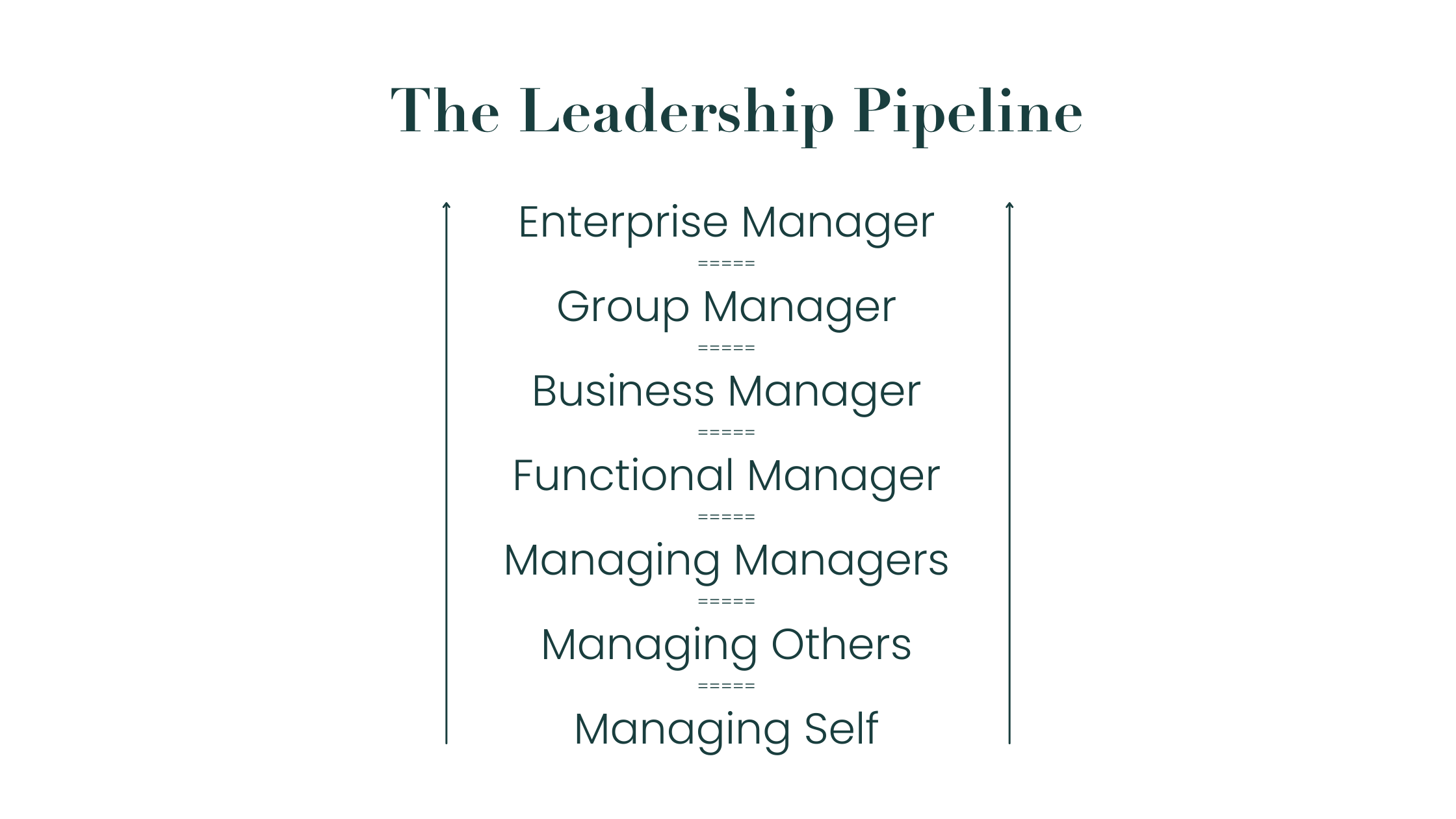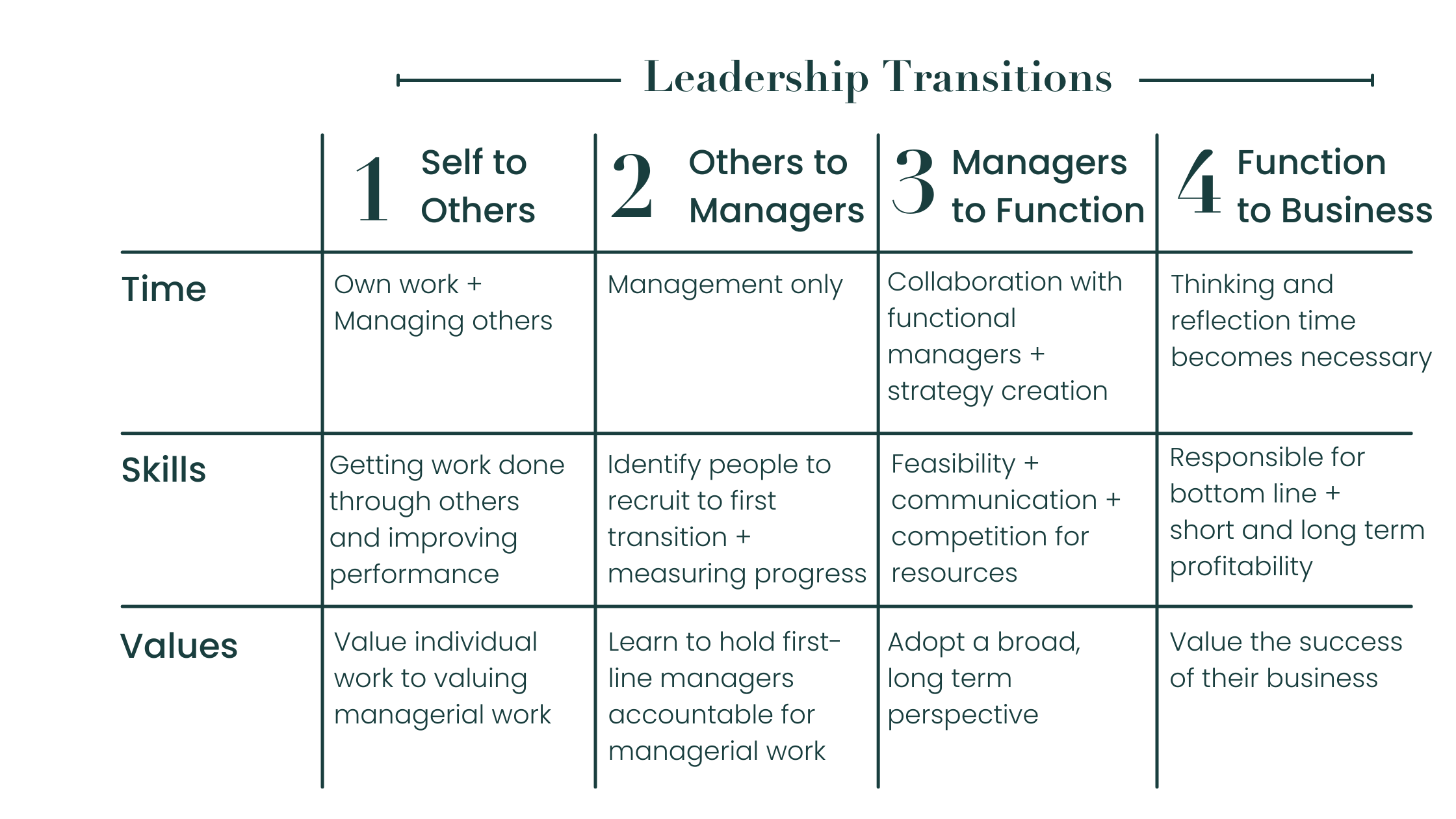How to know when change is needed: a cheat-sheet for professional growth
When you’re promoted to a more senior role in the corporate space, it comes with new objectives and metrics. You understand that what made you successful in your previous role often isn’t what will make you successful in your new one.
For founder CEOs, there is no neatly packaged promotion. The requirements of your role and measures of success change as your company grows. However, your title of CEO remains the same.
To succeed, you must continually evolve and redefine your role to meet your business’s ever-changing requirements. No easy task.
Photo credit: Ales Maze on Unsplash
The leadership pipeline is a tool founders can use to assist in the process of identifying when it’s time to redefine your role. It can also help you set expectations and manage leaders reporting to you.
What is the leadership pipeline?
Drotter, Noel and Charan’s
Leadership Pipeline Model
Building, developing and maintaining a pipeline of skilled, prepared leaders within an organisation. The leadership pipeline prepares future management talent by explaining the essential changes they must make to succeed at each stage.
Building, developing and maintaining a pipeline of skilled, prepared leaders within an organisation. The leadership pipeline prepares future management talent by explaining the essential changes they must make to succeed at each stage.
The leadership pipeline identifies six defined transitions (passages) leaders go through. Each passage identifies the necessary changes leaders must make in response to the new demands of their role, defined in terms of time application, skills, and work values.
How does the leadership pipeline help founders?
Founder CEOs don’t always recognise their need to change (much to the frustration of their teams). For them, there is no promotion informing them they’ve arrived at the next stage of their leadership development.
Think of the leadership pipeline as a cheat sheet helping you to anticipate transitions ahead of time. It identifies critical changes in organisational structure and complexity before they happen, pre-empting the requirement for change, allowing you to anticipate and develop the necessary skills in advance.
It illustrates critical trigger points for reevaluation ahead of your company’s growth and creates a framework for defining the focus of a founder’s ever-changing role.
The six transitions in the leadership pipeline are explained at the end of this article.
Applying the leadership pipeline to the founder journey
The table below sets out the time application, skills, and work values required for each transition identified by Drotter et al.:
For founder CEOs, and most people, the transition from managing self to managing others, is the most challenging transition to make. Founders particularly struggle with delegating and letting go of control. Fundraising usually forces this point as it takes up to 80% of a founder’s time, requiring the team to step up and the founder to let go.
The transition from managing others to managing managers can be equally challenging for founders as they become more distant from the day-to-day work and hiring decisions. They must learn to trust their team. Managers often want to shape the vision, and founders are apprehensive about others’ understanding the business as they do and the culture of the company changing.
Founders are also business managers from day one, so they always have one foot in transition 4. They are the business owner and must create time to step back and think about the big picture, even in the early days.
Once a founder starts working with a VC or significant investor and appoints a Board, the dynamics change again. A VC’s role has the qualities of a Group Manager. Thinking of them in this way can help you to anticipate the dynamics of introducing new stakeholders and the extra layer of governance.
In summary
Every founder wants to become a remarkable CEO and lead their company to success. To do so you must adapt quickly and effectively.
Each stage of the pipeline illustrates the changes in your organisational structure that should trigger a reassessment of your role. By recognising these triggers and knowing what changes are required of you, you can start planning in advance of the organisational change.
Your first step is to create a roadmap to navigate the transition successfully.
Use our leadership transitions map below to help you see where you are, and where you need to be.
Founder Coaching with Aata
Now you have your starting point for mapping your leadership journey.
Plotting the most effective path, and accelerating your leadership development ahead of your company’s growth curve, may require the support of a specialist founder coach.
Aata’s Leadership Check-in is a great place to get clarity on where you are, adjust your perspective, and rethink your role in your business.
Over 6 weeks, you’ll take a detailed look at your current activities and embark on new ways of leading as your business scales sustainably.
It starts with a free, no-strings chemistry call.
Six Passages in the Leadership Pipeline
Transition 1: Managing self to managing others
When you begin managing others, you must adjust your use of time, skills, and values from completing output-oriented tasks yourself to effectively managing others’ performance.
Transition 2: Managing others to managing managers
All individual tasks stop, and your time is solely spent managing others. You begin to attach value to holding managers accountable for their managerial work and identifying future management talent to coach through the pipeline.
Transition 3: Managing managers to functional manager
Managing a function requires a broader, longer-term perspective and a focus on collaborative, strategic thinking.
Transition 4: Functional manager to business manager
Allocating time to think is an essential requirement to becoming an effective business manager. Now responsible for the bottom line, short and long-term activities’ profitability become your primary focus. Improved business performance becomes your success metric.
Transition 5: Business manager to group manager
At this stage, success becomes indirect. You are now responsible for developing several businesses and business managers, creating and implementing a portfolio strategy, and allocating and deploying capital. Your focus becomes evaluating whether individual businesses have the core capabilities to succeed. You define value as the success of the portfolio.
Transition 6: Group manager to enterprise manager
An enterprise manager lets go of the individual pieces to focus on the whole portfolio, moving from an operating to a global perspective. Your focus becomes on setting direction and creating mechanisms that drive growth and performance in the long term.
For more information about the leadership pipeline model visit: 12 Manage Executive Fast Track.




